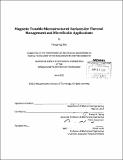Magnetic tunable microstructured surfaces for thermal management and microfluidic applications
Author(s)
Zhu, Yangying
DownloadFull printable version (8.770Mb)
Other Contributors
Massachusetts Institute of Technology. Department of Mechanical Engineering.
Advisor
Evelyn N. Wang.
Terms of use
Metadata
Show full item recordAbstract
Micro and nanostructured surfaces have broad applications including heat transfer enhancement in phase-change systems and liquid manipulation in microfluidic devices. While significant efforts have focused on fabricating static micro/nanostructured arrays, uniform arrays that can be dynamically tuned have not yet been demonstrated. In this work, we present a novel fabrication process for magnetically tunable microstructured surfaces, where the tilt angle can be controlled upon application of an external magnetic field. We also demonstrated this platform for droplet manipulation in heat transfer applications. The tunable surfaces consist of ferromagnetic nickel (Ni) pillars on a soft PDMS substrate. The pillars have diameters of 23-35 [mu]m, pitches of 60-70 [mu]m, and heights of 70-80 [mi]m. We used vibrating sample magnetometry to obtain hysteresis loops of the Ni pillar arrays which match well the properties of bulk Ni. With a field strength of 0.5 tesla and a field angle of 600, a uniform 10.5± 1 tilt angle of the pillar arrays was observed. Furthermore, we developed a model to capture the tilt angle as a function of the magnetic field, and showed that by replacing nickel to cobalt, the tilt angle could be increased to 30' with the same field. Meanwhile, simulations show good agreement with the experiments. Future work will focus on using these surfaces to actively transport water droplets and spread the liquid film via pillar movement. This work promises tunable surface designs for important device platforms in microfluidics, biological and optical applications.
Description
Thesis (S.M.)--Massachusetts Institute of Technology, Dept. of Mechanical Engineering, 2013. Cataloged from PDF version of thesis. Includes bibliographical references (p. 46-47).
Date issued
2013Department
Massachusetts Institute of Technology. Department of Mechanical EngineeringPublisher
Massachusetts Institute of Technology
Keywords
Mechanical Engineering.